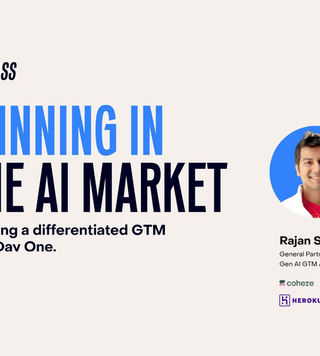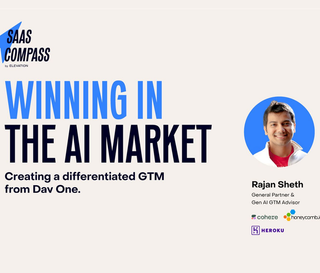Winning In The AI Market: Creating A Differentiated GTM From Day One

Winning In The AI Market: Creating A Differentiated GTM From Day One

Winning In The AI Market: Creating A Differentiated GTM From Day One

Winning In The AI Market: Creating A Differentiated GTM From Day One

New waves of innovation are constantly emerging in a rapidly evolving AI market—from content generation to vector databases to open-source models to agents. This presents an enormous but narrow window of opportunity for startups to establish market leadership. However, it's very challenging to define and sustain differentiation. To stand out in this crowded market, it's crucial to have a clear go-to-market (GTM) strategy from day one.
Recently, Poorvi Vijay, VP at Elevation dived deep with Rajan Sheth on creating differentiated and winning GTMs from day one. As a marketing and growth leader at Cohere, Rajan was instrumental in creating a unique positioning for the company in this competitive environment. Previously, he also helped scale Heroku and Box to multi-million dollar companies. As the General Partner and Gen AI GTM Advisor at Hypergrowth, he advises companies across the Gen AI stack, fueling their growth from inception.
This discussion explores a wealth of actionable advice for founders looking to build successful AI companies.
Key Highlights
Before we do a deep dive, here are the top highlights from the session at a glance:
- Define your positioning before building: Determine your positioning even before building the product. It should come from your vision, not just the product itself.
- Articulate your differentiation: Succinctly define how you are different using a simple 2D axis. Place your logo in the top right quadrant, and define what those axes should be based on your key differentiators vs competitors
- Embrace a long-term vision: Build for the market 1 year from now to have a long-term edge. Have theses and hypotheses to inform your GTM strategy.
- Don’t be everything to everyone: Choose your target customer segment (ICP) and focus on their needs, both practitioners and decision-makers.
- Build your brand on beliefs: Branding is more about vision than the product. Stand out in the news cycle by focusing on founders and beliefs rather than just joining the hype.
- Invest in organic marketing channels: Traditional paid marketing doesn't work well for getting leads in AI. Instead, focus on thought leadership, valuable content, PR, and inserting your voice into key conversations.
- Focus on perceived value while pricing: Base pricing on the value you provide to customers. There has to be a perceived value for users to justify premium
- Don’t offer free POCs: Charge for POCs, even nominally, to create urgency and demonstrate value. Use a credits model where customers pay upfront and get credits if they convert.
- Collaborate with incumbents: Build moats beyond just product through your team, vision, and partnerships. Collaborate with incumbents to reach a wider audience and leverage their existing infrastructure.
The AI market isn't just riding a single wave; it's experiencing a series of transformative surges. From content startups and vector databases to search and recommendation engines, open-source models, and agents, diverse trends are emerging across the stack. This dynamic environment creates a fertile ground for innovation, making now the ideal time to build and capitalize on new categories. While the opportunity for differentiation is vast, it is also fleeting. The AI landscape is evolving at breakneck speed, with new technologies and companies surfacing weekly. To thrive, businesses must swiftly and clearly articulate their unique value proposition, setting themselves apart from the competition.
Positioning: The Cornerstone of Successful Landing
When should you start thinking about positioning?
Determine your positioning even before starting to build the product. Positioning isn't just a box to check off once your product is ready. It's the core of your strategy, beginning before you even start building. Your positioning should be a clear reflection of your vision of the customer problem you're aiming to solve. This vision-driven approach ensures a strong foundation for differentiation. By starting early, you pave the way for standing out from the competition right from the start. More often than not, early stage companies are so focused on building the product that they don’t pay as much attention to positioning and creating differentiation from the get-go. But this is the #1 reason why companies even with great products sometimes struggle to scale the business.
Strategies For Clear Differentiation
How to define your differentiation?
Your differentiation needs to be deeply rooted in your thesis about your target market. It can’t be based on just a few feature differentiation, or some changes in the narrative or pricing. In the case of Cohere,they focused on a core thesis about their target market. Unlike OpenAI, which tried to cater to everyone, Cohere focused on a subsection of the market - enterprise customers.
Cohere identified that enterprise customers were seeking generative AI strategies, and there was significant potential for adoption and productivity gains in this market. As a result, they pivoted and positioned themselves entirely for the enterprise market. Cohere defined their differentiation using two axes: data privacy and enterprise use cases. They continuously adapted their positioning based on market changes, such as the emergence of open-source models like LLAMA 2. Positioning oneself as a leader in the market requires consistent effort. Over time, Cohere established themselves as a leader in enterprise generative AI, encompassing more than just language models and model generation. Instead of having customers send their data to the models, Cohere offered to send their models to the companies via VPCs and private deployments, ensuring data security and privacy.
Crafting The Optimal GTM Strategy
Anticipating market trends
Don't just build for the market as it exists today. Anticipate where the market is heading and develop a long-term thesis to guide your GTM strategy.
When Rajan joined Cohere pre-ChatGPT, he took a bet that companies would find it difficult to adopt LLMs due to a lack of awareness and technical resources. To address this, Cohere built an "LLM University," which helped drive awareness about the brand and company. At that time, they weren’t selling their solution but actually creating awareness about LLMs and how to use them well. They started by creating smaller modules explaining concepts like Transformers and Similarity in Embedding models, which gained significant traction. Within nine months, over 40% of Cohere's traffic came from LLM University. This strategic foresight is reminiscent of how Salesforce fostered an ecosystem by helping developers upskill, creating immense value for customers.
Bottom-Up or Top-Down GTM?
Where you get your first 10 customers is a very difficult question for B2B SaaS and AI in general. Rather than focusing on a specific approach like bottoms up or tops down, companies should:
- Identify their ICP: Clearly define their target customer segment (ICP), including both decision-makers and practitioners.
- Develop targeted strategies: Craft GTM strategies that cater specifically to the needs and preferences of their ICP.
A developer-focused product may necessitate both bottom-up and top-down motions, with the former targeted at end users and the latter at buyers. But both should be tailored based on your ICP. Startups with a narrow vertical focus will have a more targeted ICP than horizontal platforms.
If you try to be everything to everyone, you are no one to anyone
Driving Awareness and Building A Brand
Importance of Brand and Community Building
Brands are more about vision than just product features. Building a brand around your founders, values, and vision is essential to stand out in a crowded market.
For eg: Cohere built a brand around their CEO, who was an author of the landmark 2017 AI research paper "Attention is all you need" that introduced the 'Transformers' deep learning architecture. They too started with small developer meetups (less than 20 people) and gradually scaled up to the point where AWS booked an entire stadium for him at AWS re:Invent. To stand out amidst the hype cycle and news, focus on thought leadership from founders around their beliefs, not just jumping on trends. For example, amidst the prevalent "doomerism" narrative from prominent AI leaders like Elon Musk and Geoff Hinton, Cohere chose not to join the bandwagon. Instead, it took a contrarian stance by positioning themselves as a company focused on solving immediate, near-term risks for enterprises, such as bias and toxicity in content. This differentiated them from the broader narratives about AI's long-term existential risks, and helped them gain a positive news cycle.Finding unusual growth levers is crucial for building a brand. Cohere had to continuously explore new ways to build their brand beyond just their product, as market awareness took center stage.
Effective Marketing Channels and Tactics
- Traditional paid marketing to drive leads hasn't worked well in AI so far.
At Cohere, paid campaigns (e.g., social media ads, Google ads) attracted users who never actually used the product frequently or paid for it. So, they shifted budgets towards using paid to drive awareness for their content instead. In AI, sometimes Paid Marketing is useful for increasing brand awareness and driving views for their content, but not for generating leads. The most effective organic channels can be thought leadership via conferences and events and earned media via proactive PR. For eg: Cohere spent $0 on brand marketing. Instead, they relied on organic methods, such as having their executive team and developers speak at panels and conferences about generative AI. They made sure to have a presence at various events, from VC gatherings to private CEO events. At one point, Cohere was participating in 30-40 panels per month, which created a flywheel effect – the more people saw them, the more invitations they received to speak at additional events. - Don't be afraid to position yourself alongside bigger players and highlight your differentiators.
In the case of Cohere, theytransformed PR from a reactive channel to a proactive one. They actively inserted themselves into ongoing conversations by publishing opinion pieces with tier-1 publishers, countering narratives put forth by competitors like OpenAI, and establishing their own positioning. Having a clear North Star in positioning via PR, such as being positioned as an "OpenAI rival," helped Cohere gain a significant edge in the market.
Staying close to the market, understanding the latest developments, and identifying the most effective channels can be the key to success in organic marketing.
Hiring the Right Talent
Key GTM roles
Finding the right talent is a significant hurdle for AI startups. There’s hardly any talent that’s native to AI. You need folks who are technically savvy and first principles strong. Talent is scarce and good talent is even more rare. Look beyond traditional backgrounds and for people who can adapt quickly vs just having domain expertise, given how rapidly the AI market moves. For PMM roles, Rajan seeks candidates with a background in strategy consulting who can develop theses and think about the market first, before aligning the product and customer needs. PMM is both a functional and evolving role, requiring a unique skill set.
When hiring for DevRel positions, Rajan prioritizes candidates who are experts in AI/ML, with experience in research, applied AI, or as builders. They should be able to explain complex concepts effectively and gather feedback from the community. Credibility through books, articles, or research papers is highly valued.
Leverage your network to identify and directly reach out to talented individuals with the right skills and experience. Seniority is less important than the core skills of market understanding and adaptability. Trust is a crucial factor in these hires.
Pricing and Monetization
Balancing Value and Cost
Pricing your AI solution requires a careful balancing act between value and cost. A few key considerations are:
1. Always think about what’s the perceived value of your product: Pricing should be based on the value provided to customers and having differentiated premium offerings, not engaging in price wars. There must be a perceived value for end-users to justify a premium price.
2. It’s okay for companies to consider multiple pricing models at the beginning: There are several vectors of pricing to consider to optimize revenue
- Usage-based pricing: the more customers use, the more they pay.
- Feature-based pricing: charging for specific features, such as private deployment.
- Product-based pricing: charging for new products or SKUs.
3. Account for cost: Be mindful of your own LLM inference costs. If you can't pass those on to customers through higher pricing, long-term profitability will suffer. Factor that in when productizing AI features. Emerging monetization models are cropping up,such as pay-per-hour for AI agents and co-pilots, which can be more cost-effective for customers compared to hiring full-time employees.
4. Don't do POCs for free, as they consume a lot of time, cost, and resources. It also helps in testing seriousness and propensity to play. You should definitely charge for POCs, even if it’s at a nominal rate to demonstrate value. Some companies use a credits model where customers pay upfront and receive credits back later if they become a paying customer. It’s a great way to help create urgency and compress sales cycles.
Building a Moat in a Fast-Moving Market
Companies are moving up and down the AI stack, with incumbents at lower levels (e.g., infrastructure) starting to provide capabilities similar to those of higher-level players (e.g., Jasper, Copy.ai). This can lead to a flattening of growth for the higher-level companies.
Startups need to consider not just their direct competitors but also incumbents above and below their stack. For example, in the infrastructure space, AWS, Nvidia, Databricks, and Snowflake are all providing inference capabilities, alongside new entrants offering inference as a point solution.
Products alone, no matter how differentiated, are not long-term moats. Instead, focus on building moats across multiple dimensions like 1.) Strength and adaptability of team 2.) Clarity and boldness of vision 3.) Ecosystem of partners and integrations.
Explore go-to-market strategies that involve partnerships with major players in the space. This could include integrating your solution into their marketplace, offering it as an add-on, or forming other types of partnerships that allow you to access their customer base. Companies are often open to such partnership models, even if there is some overlap in competition, as they are keen to drive adoption of their own products through features they don't currently have.
Conclusion
In the dynamic AI market, standing out requires more than just a great product.
Start positioning early, clearly define your differentiation, anticipate market trends, and craft a targeted GTM strategy. Winning involves understanding your market, building a strong brand, and continuously adapting. If you are building in AI and looking for help on GTM, we would love to grab a coffee. Please reach out at poorvi@elevationcapital.com.